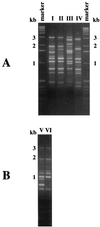Epidemiological evidence for dormant Cryptococcus neoformans infection
- PMID: 10488178
- PMCID: PMC85528
- DOI: 10.1128/JCM.37.10.3204-3209.1999
Epidemiological evidence for dormant Cryptococcus neoformans infection
Abstract
To date, the time of acquisition of a Cryptococcus neoformans infectious strain has never been studied. We selected a primer, (GACA)(4), and a probe, CNRE-1, that by randomly amplified polymorphic DNA (RAPD) analysis and restriction fragment length polymorphism (RFLP), respectively, regrouped strains from control samples of C. neoformans var. grubii environmental isolates according to their geographical origins. The two typing techniques were then used to analyze 103 isolates from 29 patients diagnosed with cryptococcosis in France. Nine of the 29 patients lived in Africa a median of 110 months prior to moving to France; 17 of the patients originated from Europe. Results showed a statistically significant clustering of isolate subtypes from patients originating from Africa compared to those from Europe. We conclude that the patients had acquired the C. neoformans infectious strain long before their clinical diagnoses were made.
Figures



References
-
- Boekhout T, van Belkum A, Leenders A C A P, Verbrugh H A, Mukamurangwa P, Swinne D, Scheffers W A. Molecular typing of Cryptococcus neoformans: taxonomic and epidemiological aspects. Int J Syst Bacteriol. 1997;47:432–442. - PubMed
-
- Brandt M E, Hutwagner L C, Klug L A, Baughman W S, Rimland D, Graviss E A, Hamill R J, Thomas C, Pappas P G, Reingold A L, Pinner R W the Cryptococcal Disease Active Surveillance Group. Molecular subtype distribution of Cryptococcus neoformans in four areas of the United States. J Clin Microbiol. 1996;34:912–917. - PMC - PubMed
-
- Casadevall A, Perfect J R. Cryptococcus neoformans. Washington, D.C: ASM Press; 1998. pp. 41–70.
-
- Chen S C A, Brownlee A G, Sorrell T C, Ruma P, Ellis D H, Pfeiffer T J, Speed B R, Nimmo G. Identification by random amplification of polymorphic DNA of a common molecular type of Cryptococcus neoformans var. neoformans in patients with AIDS or other immunosuppressive conditions. J Infect Dis. 1996;173:754–758. - PubMed
Publication types
MeSH terms
LinkOut - more resources
Full Text Sources

